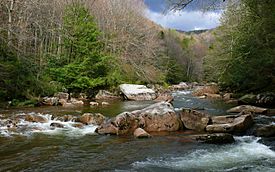Williams River (West Virginia) facts for kids
Quick facts for kids Williams River |
|
|---|---|

Williams River in the Monongahela National Forest.
|
|
| Country | United States |
| State | West Virginia |
| Counties | Pocahontas, Webster |
| Physical characteristics | |
| Main source | Beaverdam Run Day Mountain, Pocahontas County, WV 3,892 ft (1,186 m) 38°14′47″N 80°09′54″W / 38.24639°N 80.16500°W |
| 2nd source | Downy Run Day Mountain, Pocahontas County, WV 3,975 ft (1,212 m) 38°14′03″N 80°09′32″W / 38.23417°N 80.15889°W |
| River mouth | Gauley River Donaldson, WV 2,169 ft (661 m) 38°23′06″N 80°30′48″W / 38.38500°N 80.51333°W |
| Length | 33 mi (53 km) |
| Basin features | |
| Basin size | 132 sq mi (340 km2) |
The Williams River is a beautiful river in West Virginia, USA. It flows for about 33 miles (53 km). This river is a smaller stream, called a tributary, that flows into the Gauley River. The water from the Williams River eventually joins the Kanawha River, then the Ohio River, and finally the mighty Mississippi River. It helps drain an area of 132 square miles (342 km²) in the Allegheny Mountains.
River's Name
The Williams River might have been named after a person with the last name Williams who owned land nearby. It was also sometimes called the South Fork of the Gauley River. There are other smaller streams that flow into the Williams River, like the Middle Fork Williams River. This Middle Fork even has its own branch called the North Branch Middle Fork Williams River!
Where the River Flows
The Williams River starts in the southern part of Pocahontas County. This is about 5 miles (8 km) west of a town called Marlinton. The river first flows north, then turns west. It eventually meets the Gauley River in Webster County. This meeting point is about 2 miles (3 km) southeast of Cowen.
Much of the Williams River flows through the Monongahela National Forest. This includes a special protected area called the Cranberry Wilderness. Long ago, in the early 1900s, this area was heavily logged for its trees. But since then, new trees have grown, and the forest has returned. Some coal mining happened along the lower parts of the river until the 1970s.
Fishing Fun
The Williams River is known as one of the top five places to fish for trout in West Virginia. Why is it so good for fishing?
- The water stays very cold.
- The water is usually clear, meaning it has low turbidity.
- The West Virginia Division of Natural Resources regularly adds trout to the river. They stock about 27,000 pounds of trout every year! This makes it a great spot for anglers (people who fish).
Images for kids




